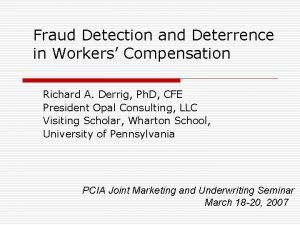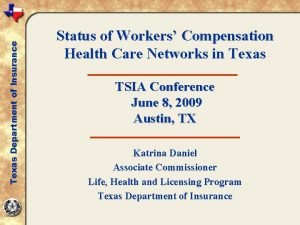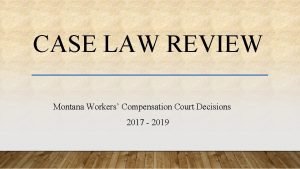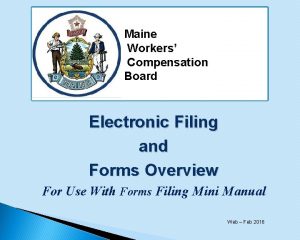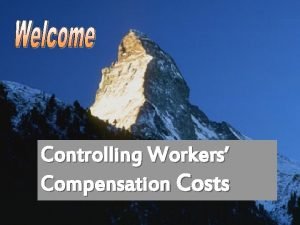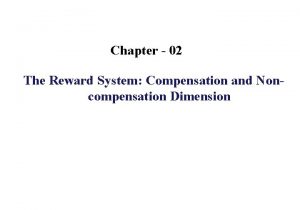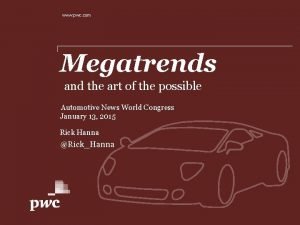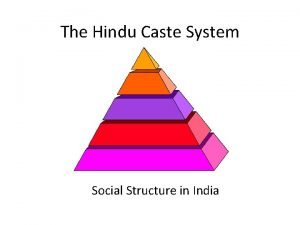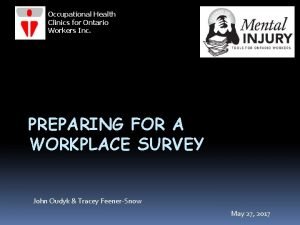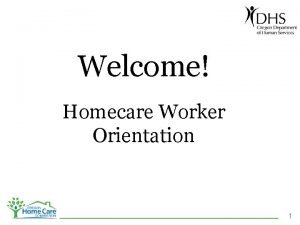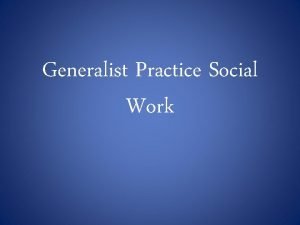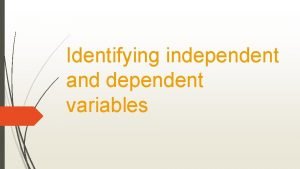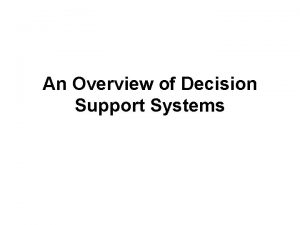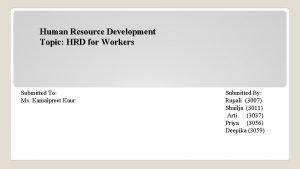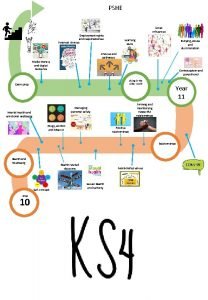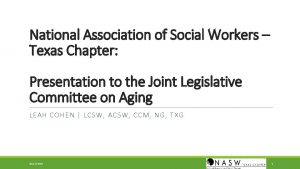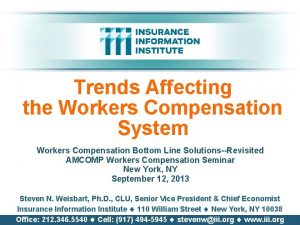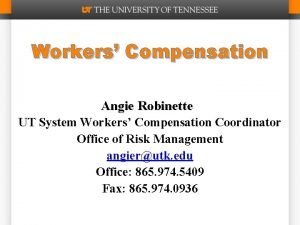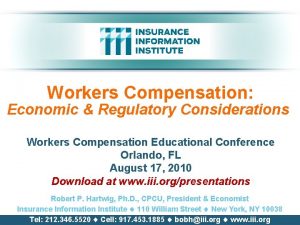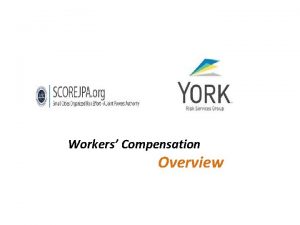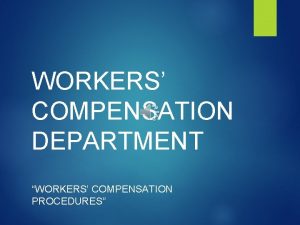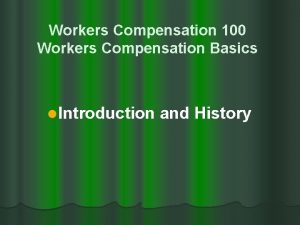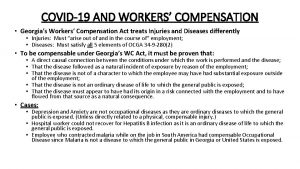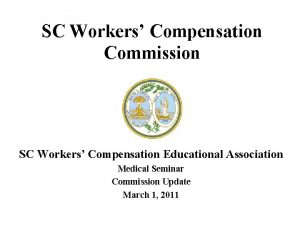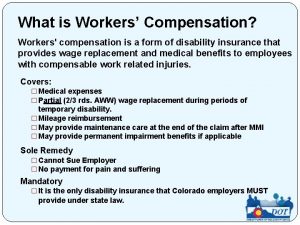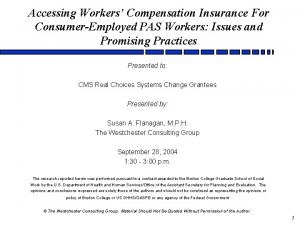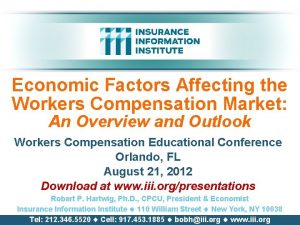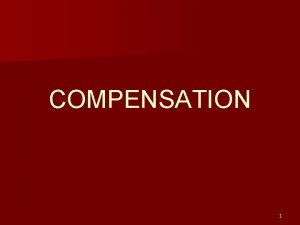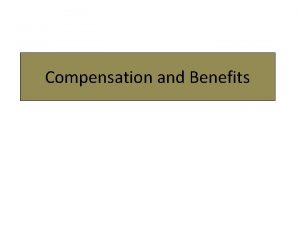MegaTrends Affecting the Workers Compensation Insurance Industry Challenges





















































































- Slides: 85

Mega-Trends Affecting the Workers Compensation Insurance Industry Challenges Amid the Economic Crisis 6 th Annual National Workers Compensation Execu. Summit Uncasville, CT February 2, 2009 Robert P. Hartwig, Ph. D. , CPCU, President Insurance Information Institute 110 William Street New York, NY 10038 Tel: (212) 346 -5520 Fax: (212) 732 -1916 bobh@iii. org www. iii. org

Presentation Outline • Economic Factors Affecting Exposure in WC Ø Economic Downturn and Inflation • Overall P/C Insurance Industry Performance Cycles • Ø Ø Profitability Underwriting Premium Growth Drivers Investment Performance Ø Ø Underwriting performance Premium Drivers Frequency & Severity Trends Predictive Modeling and Workers Comp Performance Review • Mega-Trends/Emerging Issues Affecting Workers Comp Ø The Aging Workforce Ø The Obesity Epidemic Non-English Speaking Workers • Other Trends & Concerns Q&A

THE ECONOMIC STORM What a Weakening Economy & Rising Unemployment Mean for Workers Comp Insurers

Real GDP Growth* Recession began in December 2007. Economic toll of credit crunch, housing slump, labor market contraction is growing The Q 4: 2008 decline was the steepest since the Q 1: 1982 drop of 6. 4% *Yellow bars are Estimates/Forecasts from Blue Chip Economic Indicators. Source: US Department of Commerce, Blue Economic Indicators 1/09; Insurance Information Institute.

Length of US Recessions, 1929 -Present* Months in Duration Current recession began in Dec. 2007 and is already the longest since 1981. If it extends beyond April, it will become the longest recession since the Great Depression. * As of February 2009 Sources: National Bureau of Economic Research; Insurance Information Institute.

Workplace Injury Incidence Rates Declined in Last 4 Economic Downturns p Preliminary Source: US Department of Labor, Bureau of Labor Statistics (BLS), National Bureau of Economic Research; NCCI Frequency and Severity Analysis

Unemployment Rate: On the Rise January 2000 through December 2008 Previous Peak: 6. 3% in June 2003 Dec. 2008 unemployment jumped to 7. 2%, exceeding the 6. 3% peak during the previous cycle Trough: 4. 4% in March 2007 Dec-08 Average unemployment rate 2000 -07 was 5. 0% Unemployment will likely peak above 8% or 9% during this cycle, impacting payroll sensitive p/c and non-life exposures Source: US Bureau of Labor Statistics; Insurance Information Institute.

U. S. Unemployment Rate, (2007: Q 1 to 2010: Q 4 F)* Rising unemployment will erode payrolls and workers comp’s exposure base. Unemployment is expected to peak above 8% in the second half of 2009. * Blue bars are actual; Yellow bars are forecasts Sources: US Bureau of Labor Statistics; Blue Chip Economic Indicators (1/09); Insurance Info. Inst.

Monthly Change Employment* (Thousands) Job losses in 2008 totaled 2. 589 million, the highest since 1945 at WW II’s end; 11. 1 million people are now defined as unemployed. The Nov. /Dec. 2008 losses were the largest since May 1980 loss of 431, 000, but less than the Dec. 1974 loss of 602, 000 Source: US Bureau of Labor Statistics: http: //www. bls. gov/ces/home. htm; Insurance Info. Institute

Years With Job Losses: 1939 -2008* (Thousands) The US has seen net job losses in only 16 of the 70 years since 1939 2008’s job losses were exceeded only by 1945, at the conclusion of WW II Source: Insurance Information Institute research from US Bureau of Labor Statistics data: http: //www. bls. gov/ces/home. htm.

New Private Housing Starts, 1990 -2010 F (Millions of Units) Exposure growth forecast for HO insurers is dim for 2009 with some improvement in 2010. Impacts also for comml. insurers with construction risk exposure New home starts plunged 34% from 2005 -2007; Drop through 2009 trough is 65% (est. )—a net annual decline of 1. 35 million units I. I. I. estimates that each incremental 100, 000 decline in housing starts costs home insurers $87. 5 million in new exposure (gross premium). The net exposure loss in 2009 vs. 2005 is estimated at about $1. 2 billion. Source: US Department of Commerce; Blue Chip Economic Indicators (1/09); Insurance Information Inst.

Auto/Light Truck Sales, 1999 -2010 F (Millions of Units) Weakening economy, credit crunch are hurting auto sales; Gas prices less of a factor now. New auto/light trick sales are expected to experience a net drop of 5. 7 million units annually by 2009 compared with 2005, a decline of 20. 7% Impacts of falling auto sales will have a less pronounced effect on auto insurance exposure growth than problems in the housing market will on home insurers Source: US Department of Commerce; Blue Chip Economic Indicators (1/09); Insurance Information Inst.

Total Industrial Production, (2007: Q 1 to 2010: Q 4 F) Obama stimulus program is expected benefit impact industrial production and therefore insurance exposure both directly and indirectly Industrial production began to contract sharply during H 2 2008 and is expected to shrink through the first half of 2009 Figures for H 2: 09 and 2010 revised sharply upwards to reflect expected impact of Obama stimulus program Sources: US Bureau of Labor Statistics; Blue Chip Economic Indicators (1/09); Insurance Info. Inst.

Wage & Salary Disbursements (Payroll Base) vs. Workers Comp Net Written Premiums Wage & Salary Disbursement (Private Employment) vs. WC NWP $ Billions 7/90 -3/91 3/01 -11/01 Shaded areas indicate recessions *9 -month data for 2008 Source: US Bureau of Economic Analysis; Federal Reserve Bank of St. Louis at http: //research. stlouisfed. org/fred 2/series/WASCUR; I. I. I. Fact Books $ Billions 12/07 -? Weakening wage and salary growth is expected to cause a deceleration in workers comp exposure growth

U. S. $825 B Economic Stimulus Package, By Category $ Billions I. I. I. Estimate Every 1 million jobs created or preserved will increase (or preserve) as much as $1 billion in workers comp premium. Obama stimulus target is 3 -4 million jobs. Commercial insurance lines that will benefit from the Obama stimulus plan include workers comp, commercial property, commercial auto, surety, inland marine and others Sources: House Appropriations Committee; Wall Street Journal, January 16, 2009

Real GDP Growth vs. Real P/C Premium Growth: Modest Association P/C insurance industry’s growth is influenced modestly by growth in the overall economy Sources: A. M. Best, US Bureau of Economic Analysis, Blue Chip Economic Indicators, 8/08; Insurance Information Inst.

Total Private Employment* Grew by 25½ Million Workers from 1991 to 2008 Millions The US economy added 25. 5 million jobs between 1991 and 2008, but job growth has recently stagnated, impacted payrolls and the workers comp exposure base *seasonally adjusted at mid-year Source: U. S. Bureau of Labor Statistics, at http: //data. bls. gov/cgi-bin/surveymost

Average Weekly Real Earnings in Private Employment Were Flat from 1999 to 2008 (at mid-year) Virtually all of the real wage growth occurred between 1995 and 1999 and has now stagnated Sources: U. S. Bureau of Labor Statistics; I. I. I. Constant 1982 dollars

New Private Housing Starts, 1990 -2014 F (Millions of Units) Exposure growth forecast for HO insurers is dim for 2008/09 Impacts also for comml. insurers with construction risk exposure New home starts plunged 34% from 2005 -2007; Drop through 2008 trough is 54% (est. )—a net annual decline of 1. 11 million units I. I. I. estimates that each incremental 100, 000 decline in housing starts costs home insurers $87. 5 million in new exposure (gross premium). The net exposure loss in 2008 vs. 2005 is estimated at $971 million. Source: US Department of Commerce; Blue Chip Economic Indicators (10/07), except 2008/09 figures from 8/08 edition of BCEF; Insurance Info. Institute

Total Industrial Production, (2007: Q 1 to 2009: Q 4 F) Industrial production affects exposure both directly and indirectly Industrial production shrank during Q 1 2008 and is expected to shrink again in Q 2, growing very slowly thereafter Sources: US Bureau of Labor Statistics; Blue Chip Economic Indicators (7/08); Insurance Info. Inst.

Medical & Tort Cost Inflation Amplifiers of Inflation, Major Insurance Cost Driver

Consumer Price Index for Medical Care vs. All Items, 1960 -2008 (Base: 1982 -84=100) Soaring medical inflation is among the most serious long-term challenges facing casualty, disability and LTC insurers Inflation for Medical Care has been surging ahead of general inflation (CPI) for 25 years. Since 1982 -84, the cost of medical care has more than tripled Source: Department of Labor (Bureau of Labor Statistics; Insurance Information Institute.

Tort Cost Growth & Medical Cost Inflation vs. Overall Inflation (CPI-U), 1961 -2008* Tort costs move with inflation but at twice the rate Tort System is an Inflation Amplifier Avg. Ann. Change: 1961 -2008* Torts Costs: +8. 4% Med Costs: +6. 0% Overall Inflation: +4. 2% *Medical cost and CPI-U from BLS. Tort figure is for full-year 2008 from Tillinghast. Sources: US Bureau of Labor Statistics, Tillinghast-Towers Perrin, 2007 Update on U. S. Tort Costs; Insurance Info. Inst.

Comparative 2008 Inflation Statistics Important to Insurers ( %) CPI and “Core” CPI are not representative of many of the costs insurers face Medical/Legal costs typically run well ahead of inflation *Core CPI is the Consumer Price Index for all Urban Consumers (CPI-U) less food and energy costs. Source: US Bureau of Labor Statistics; Insurance Information Institute.

P/C INSURANCE FINANCIAL PERFORMANCE A Resilient Industry in Challenging Times

P/C Net Income After Taxes 1991 -2009 F ($ Millions)* 2001 ROE = -1. 2% 2002 ROE = 2. 2% 2003 ROE = 8. 9% 2004 ROE = 9. 4% 2005 ROE= 9. 4% 2006 ROE = 12. 2% 2007 ROAS 1 = 12. 3% 2008 ROAS = 1. 1%* Insurer profits peaked in 2006. *ROE figures are GAAP; 1 Return on avg. surplus. 2008 numbers are annualized based on 9 -mos. Actual of $4. 066 billion. 29 Sources: A. M. Best, ISO, Insurance Information Inst.

P/C Insurance Industry ROEs, 1975 – 2008 E* 1977: 19. 0% 1987: 17. 3% 1997: 11. 6% 2006: 12. 2% 10 Years 10 Y ears 9 Years 2008 F: 1. 1% 1975: 2. 4% 1984: 1. 8% Note: 2008 figure is actual 9 -month result. Sources: ISO; Insurance Information Institute. 1992: 4. 5% 2001: -1. 2% 30

ROE vs. Equity Cost of Capital: US P/C Insurance: 1991 -2008: Q 3 US P/C insurers missed their cost of capital by an average 6. 7 points from 1991 to 2002, but on target or better 2003 -07 *Excludes mortgage and financial guarantee insurers. Source: The Geneva Association, Ins. Information Inst. -9. 7 pts +2. 3 pts -1. 7 pts -9. 0 pts -13. 2 pts The p/c insurance industry fell well short of is cost of capital in 2008 The cost of capital is the rate of return insurers need to attract and retain capital to the business 31

P/C Insurance Combined Ratio, 1970 -2008 F* Combined Ratios 1970 s: 100. 3 1980 s: 109. 2 1990 s: 107. 8 2000 s: 102. 0* Sources: A. M. Best; ISO, III 32 *A. M. Best year end estimate of 103. 2; Actual 9 -mos. result was 105. 6.

P/C Insurance Industry Combined Ratio, 2001 -2009 E As recently as 2001, insurers paid out nearly $1. 16 for every $1 in earned premiums Relatively low CAT losses, reserve releases 2005 ratio benefited from heavy use of reinsurance which lowered net losses Best combined ratio since 1949 (87. 6) *Includes Mortgage & Financial Guarantee insurers. Including Mortgage & Fin. Guarantee insurers Cyclical Deterioration Sources: A. M. Best. 33

Commercial Lines Combined Ratio, 1993 -2009 F Commercial coverages have exhibited significant variability over time. 2006/07 benefited from favorable loss cost trends, improved tort environment, low CAT losses, WC reforms and reserve releases. Most of these trends reversed in 2008 and mortgage and financial guarantee segments have big influence. 2009 is transition year. Sources: A. M. Best (historical and forecasts) Mortgage and financial guarantee may account for up to 4 points on the commercial combined ratio in 2008

Underwriting Gain (Loss) 1975 -2008: Q 3* $ Billions Insurers earned a record underwriting profit of $31. 7 billion in 2006, the largest ever but only the second since 1978. Cumulative underwriting deficit from 1975 through 2007 is $422 billion. $19. 877 Bill underwriting loss in 08: 9 M incl. mort. & FG insurers Source: A. M. Best, ISO; Insurance Information Institute 36 insurers * Includes mortgage & finl. guarantee

Number of Years With Underwriting Profits by Decade, 1920 s – 2000 s Number of Years with Underwriting Profits Underwriting profits were common before the 1980 s (40 of the 60 years before 1980 had combined ratios below 100)—but then they vanished. Not a single underwriting profit was recorded in the 25 years from 1979 through 2003. Note: Data for 1920 – 1934 based on stock companies only. Sources: Insurance Information Institute research from A. M. Best Data. 37 *2000 through 2008.

Strength of Recent Hard Markets by NWP Growth 1975 -78 1984 -87 Shaded areas denote “hard market” periods 2000 -03 Net written premiums fell 1. 0% in 2007 (first decline since 1943) and by 0. 4% in 2008, the first backto-back decline since 1930 -33 38 Sources: A. M. Best, ISO, Insurance Information Institute

Year-to-Year Change in Net Written Premium, 2000 -2008 E* P/C insurers are experiencing their slowest growth rates since 1930 -33 Slow growth means retention is critical *2008 figure is 9 -month actual result from ISO. Source: A. M. Best (historical) Protracted period of negative or slow growth is possible due to soft markets and slow economy 39

Distribution of P/C Insurance Industry’s Investment Portfolio Facts As of December 31, 2007 • Invested assets totaled $1. 3 trillion as of 12/31/07 • Insurers are generally conservatively invested, with 2/3 of assets invested in bonds as of 12/31/07 • Only about 18% of assets were invested in common stock as of 12/31/07 • Even the most conservative of portfolios was hit hard in 2008 Source: NAIC; Insurance Information Institute research; . 40

Property/Casualty Insurance Industry Investment Gain: 1994 - 2008: Q 3 1 Investment gains are off sharply in 2008 due to lower yields and poor equity market conditions. 1 Investment gains consist primarily of interest, stock dividends and realized capital gains and losses. 2006 figure consists of $52. 3 B net investment income and $3. 4 B realized investment gain. *2005 figure includes special one-time dividend of $3. 2 B. 41 Sources: ISO; Insurance Information Institute.

P/C Insurer Net Realized Capital Gains, 1990 -2008: Q 3 $ Billions Realized capital gains exceeded $9 billion in 2004/5 but fell sharply in 2006 despite a strong stock market. Nearly $9 billion again in 2007, but $ -9. 7 billion in 2008 through Q 3. Sources: A. M. Best, ISO, Insurance Information Institute. 42

Workers Compensation Review: Underwriting and Operating Performance

Workers Comp Combined Ratios, (Calendar Year, Private Carriers) 1994 -2007 p Percent p Preliminary. Sources: Calendar Years 1994 -2006, A. M. Best Aggregates & Averages; Calendar Year 2007 p NCCI Includes dividends to policyholders WC insurers lopped 30 points off the combined ratio in just 5 years

Workers Comp Combined Ratios, 1994 -2008 F* Percent A. M. Best expects 2008 combined ratio to rise by 2. 5 points p Preliminary AY figure. Accident Year data is evaluated as of 12/31/2007 and developed to ultimate Source: Calendar Years 1994 -2006, A. M. Best Aggregates & Averages; Calendar Year 2007 p and Accident Years 1994 -2007 pbased on NCCI Annual Statement Analysis. Includes dividends to policyholders *2008 figure from A. M. Best.

Calendar Year Reserve Deficiencies Continue to Decline $ Billions WC Loss and LAE Reserve Deficiency: Private Carriers 2007 Tabular Discount Is $5. 5 Billion Calendar Year Considers all reserve discounts as deficiencies Loss and LAE figures are based on NAIC Annual Statement data for each valuation date and NCCI latest selections Source: NCCI analysis

Workers Comp Cost Drivers Medical/Indemnity Frequency & Severity Trends

Workers Compensation Medical Claim Trends

Workers Comp Medical Claims Costs Continue to Climb Medical Claim Cost ($000 s) Annual Change 1991– 1993: Annual Change 1994– 2001: Annual Change 2002 -2006: +1. 9% +8. 9% +7. 8% Cumulative Change = +200% (1993 -2007 p) Accident Year 2007 p: Preliminary based on data valued as of 12/31/2007 1991 -2006: Based on data through 12/31/2006, developed to ultimate Based on the states where NCCI provides ratemaking services; Excludes the effects of deductible policies

WC Medical Severity Rising at Double the Medical CPI Rate Average annual increase in WC medical severity from 1995 through 2007 was more than twice the medical CPI rate (8. 2% vs. 4. 0%) Sources: Med CPI from US Bureau of Labor Statistics, WC med severity from NCCI based on NCCI states.

Med Costs Share of Total Costs is Increasing Steadily 2007 p 1997 1987 Source: NCCI (based on states where NCCI provides ratemaking services).

WC Med Cost Will Equal 70% of Total by 2017 if Trends Hold 2017 Estimate This trend will likely be supported by the increased labor force participation of workers age 55 and older. Source: Insurance Information Institute.

Indemnity Claim Cost Trends

Workers Compensation Indemnity Claim Costs Growth Is Moderate Lost-Time Claims Indemnity Claim Cost ($ 000 s) Annual Change 1991– 1993: Annual Change 1994– 2001: Annual Change 2002– 2006: -1. 7% +7. 3% +3. 1% Accident Year 2007 p: Preliminary based on data valued as of 12/31/2007 1991– 2006: Based on data through 12/31/2006, developed to ultimate Based on the states where NCCI provides ratemaking services Excludes the effects of deductible policies

WC Indemnity Severity vs. Wage Inflation WC indemnity severity is once again outpacing wage inflation 2006 p: Preliminary based on data valued as of 12/31/2006; 1991 -2005: Based on data through 12/31/2005, developed to ultimate. Based on the states where NCCI provides ratemaking services. Excludes the effects of deductible policies. CPS = Current Population Survey. Source: NCCI

Residual Market Overview

Workers Compensation Residual Market Underwriting Results NCCI-Serviced Workers Compensation Residual Market Pools as of December 31, 2007 $ Millions Policy Year * Incomplete Policy Year Projected to Ultimate Source: NCCI

Investment Performance

Workers Compensation Investment Returns Remain Below Historical Average Percent Investment Gain on Insurance Transactions-to-Premium Ratio Private Carriers Average (1990– 2006): 15. 3% Calendar Year p Preliminary * Adjusted to include realized capital gains to be consistent with 1992 and after Investment Gain on Insurance Transactions includes Other Income Source: 1990– 2006, Best's Aggregates & Averages; 2007 p, NCCI

Premium Growth & Pricing Environment

Total Workers Compensation Premium Declined Again in 2007 $ Billions Net Written Premium Calendar Year p Preliminary Source: 1990– 2006 Private Carriers, A. M. Best Aggregates & Averages; 2007 p, NCCI 1996– 2007 p State Funds: AZ, CA, CO, HI, ID, KY, LA, MO, MT, NM, OR, RI, TX, UT Annual Statements State Funds available for 1996 and subsequent

History of Average WC Bureau Rate/ Loss Cost Level Changes Percent Cumulative 2000 -2003 +17. 1% Cumulative 1994 -1999 -27. 8% Cumulative 2004 -2008 -24. 0% Cumulative 1990 -1993 +36. 3% Calendar Year * States approved through 4/11/2008 Countrywide approved changes in advisory rates, loss costs and assigned risk rates as filed by the applicable rating organization

Current NCCI Voluntary Market Filed Rate/Loss Cost Changes Percent States filed through 4/18/2008 Source: NCCI Excludes Law-Only Filings

Alternative Risk Transfer Market Saps Traditional WC Carriers $ Billions Workers Comp account for the largest share of the alternative market, particularly captives Source: Market. Stance.

FREQUENCY & SEVERITY TRENDS

Injury & Fatality Incidence Rates and Claim Cost Trends

Rate of Work-Related Injuries Decreases Over Time Due to Improved Working Conditions Rate of Injury per 100 FTE Workers Source: US Department of Labor, Bureau of Labor Statistics; NCCI

Workers Comp Lost-Time Claim Frequency Down More than 50% Since 1991 Cumulative Change of – 53. 3% since 1991 means that lost work time claims have been cut by more than half Percent Change Accident Year 2007 p: Preliminary based on data valued as of 12/31/2006 1991 -2006: Based on data through 12/31/2005, developed to ultimate Based on the states where NCCI provides ratemaking services Excludes the effects of deductible policies Source: NCCI

1997 -2006: Claim Frequency Declined for All Injury Types Other Than Permanent Total Percentage Change Between Policies Expiring in 1997 and 2006 Claim Frequency per $1 M of Wage-Adjusted Payroll All NCCI states except NV and TX Source: NCCI Unit Statistical Plan data, First Report

Lost-Time Claim Frequency Declined for All Industry Groups Percentage Change Between Policies Expiring in 2002 and 2006 Claim Frequency per $1 M of Wage-Adjusted Payroll All NCCI states except NV and TX Source: NCCI Unit Statistical Plan data, First Report Source: NCCI

Permanent Total Claim Frequency by Industry Group Percentage Change Between Policies Expiring in 2002 and 2006 Claim Frequency per $1 M of Wage Adjusted Payroll All NCCI states except NV and TX Source: NCCI Unit Statistical Plan data, First Report Source: NCCI

WHY YOU SHOULD FEEL GOOD ABOUT WHAT YOU DO Saving Lives, Increasing Productivity and Much More It’s Not Just About the Money

Did You Know That When You Prevent a Workplace Injury You… • Keeping Workers Comp Costs Down is Just the Beginning • You Help Companies Remain Productive 1 Ø Permanently Disabling Injuries 565 Lost Future Work Days on Avg. Ø Fatal Injuries 5, 850 Lost Future Work Days on Average • You Increase/Preserve Worker Incomes Ø Seriously Injured Workers Have Lower Lifetime Earnings, on Average Ø Reduced Likelihood of Filing Bankruptcy Ø Less Likely to Need Public Assistance • You Maintain/Improve the Quality of Worker’s Home Life Ø Higher Incidence of Divorce, Substance Abuse, Depression Among Seriously Injured 1 ALL REASONS TO BE PROUD OF WHAT YOU DO!! US Census Bureau: http: //www. census. gov/compendia/statab/tables/07 s 0639. xls

Workers Comp Lost-Time Claim Frequency Down More than 50% Since 1991 Cumulative Change of – 53. 3% since 1991 means that lost work time claims have been cut by more than half Percent Change Accident Year 2007 p: Preliminary based on data valued as of 12/31/2006 1991 -2006: Based on data through 12/31/2005, developed to ultimate Based on the states where NCCI provides ratemaking services Excludes the effects of deductible policies Source: NCCI

Number of Fatal Work Injuries is Continues to Fall, 1992 – 2007 p Workers comp insurers & the entire workplace safety community have contributed to the 17% decline in workplace fatalities since 1994 Source: US Bureau of Labor Statistics, US Department of Labor; III. *Excludes 9/11 deaths.

Lives Saved Due to Reduction in Fatal Work Injury Rate, 1995– 2006 Reduction in Occupational Deaths Due to Fall in Fatality Rate from 5. 3 per 100, 000 Workers in 1994 to 4. 0 in 2006 Workers comp insurers are a major force in saving worker lives Nearly 2, 000 work lives are saved annually due to improved workplace safety! Source: Insurance Information Institute from BLS data.

Cumulative Lives Saved Due to Reduction in Fatal Work Injury Rate Cumulative Lives Saved Due to Fall in Fatality Rate from 5. 3 per 100, 000 Workers in 1994 to 4. 0 in 2006 Since 1994, nearly 15, 000 worker lives have been saved due to improved workplace safety! Saving a Life, Saves a Family Source: Insurance Information Institute from BLS data.

EMERGING TRENDS & CHALLENGES IN WORKERS COMP

#1 Emerging (Mega) Trend The Obesity Epidemic

WC Medical Claims Costs are 6. 8 x Higher for the Most Obese Workers Indemnity costs are 11 times higher for the most obese workers than for healthyweight workers. Source: Ostbye, T. , et al, “Obesity and Workers Compensation, ” Archives of Internal Medicine, April 23, 2007.

It’s Not All Because of Obesity: “Confounding Factors” Some people with high BMI also have other characteristics that contribute to disability and/or death. They… Ø Smoke and/or regularly drink alcohol heavily Ø Are older and/or male Ø Have chronic diseases (e. g. , diabetes, heart disease) Ø Have other conditions/circumstances (e. g. , no health insurance, don’t exercise) that are related to poor health Failure to adjust for these “confounding factors” likely results in overstating the effect of obesity. Source: Flegal, Graubard, Williamson, and Gail, “Excess Deaths Associated with Underweight, Overweight, and Obesity, ” JAMA Vol. 293, No. 15 (April 20, 2005) pp. 1861 -1867.

#2 Emerging (Mega)Trend The Aging Workforce

U. S. Workforce is Aging: Significant Implications for Workers Comp Median Age of U. S. Worker Older and less healthy workforce The median age of US workers as the Baby Boomer begin to retire is about 41 years. Immigration will hold this number down and may even lower the figure. Year Source: US Bureau of Labor Statistics, 2004.

Fatal Work Injury Rates Climb Sharply With Age Fatal Work Injuries per 100, 000 Workers (2006) The fatality rate for workers 65 and older is triple that of workers age 35 -44. The workplace of the future will have to be completely redesigned to accommodate the surge in older workers. Source: US Bureau of Labor Statistics, US Department of Labor; Insurance Information Institute.

Older Workers Have More Lost Time from Work Due to Injury or Illness Median Days Away From Work (2005) Age 65+ workers median lost time is 50% greater than workers age 35 -44 There will be more lost time as the workforce ages in the future. Source: US Bureau of Labor Statistics, US Department of Labor

Percentage of Non-Commissioned Officers Suffering from Symptoms of PTSD by Number of Deployments… Symptoms of PTSD are 54% more likely to be observed in second deployments and 125% higher in third or fourth deployments Source: Brookings Institution, Iraq Index Archive, updated August 18, 2008.

#3 Emerging (Mega) Trend Non-English Speaking Workers

Fatal Worker Injury Rates by Race and Ethnicity, 2006 Fatality Rate per 100, 000 Workers Employed Hispanic workers experience highest rate of fatal injuries on the job Source: U. S. Dept. of Labor, Bureau of Labor Statistics, Census of Fatal Occupational Injuries, 2006

Insurance Information Institute On-Line If you would like a copy of this presentation, please give me your business card with e-mail address
 Workers compensation fraud detection
Workers compensation fraud detection Texas hcn workers compensation
Texas hcn workers compensation Workers compensation court montana
Workers compensation court montana Oregon workers compensation division
Oregon workers compensation division Work comp puncture
Work comp puncture Maine workers compensation forms
Maine workers compensation forms Maine workers compensation forms
Maine workers compensation forms Controlling workers compensation costs
Controlling workers compensation costs Noncompensation
Noncompensation Megatrends pwc
Megatrends pwc American megatrends inc. bios
American megatrends inc. bios American megatrends
American megatrends Fire insurance introduction
Fire insurance introduction Bpo challenges
Bpo challenges Thẻ vin
Thẻ vin Cái miệng nó xinh thế
Cái miệng nó xinh thế Các châu lục và đại dương trên thế giới
Các châu lục và đại dương trên thế giới Từ ngữ thể hiện lòng nhân hậu
Từ ngữ thể hiện lòng nhân hậu Bổ thể
Bổ thể Tư thế ngồi viết
Tư thế ngồi viết Diễn thế sinh thái là
Diễn thế sinh thái là Ví dụ về giọng cùng tên
Ví dụ về giọng cùng tên Làm thế nào để 102-1=99
Làm thế nào để 102-1=99 Thể thơ truyền thống
Thể thơ truyền thống Chúa yêu trần thế
Chúa yêu trần thế Khi nào hổ mẹ dạy hổ con săn mồi
Khi nào hổ mẹ dạy hổ con săn mồi đại từ thay thế
đại từ thay thế Vẽ hình chiếu vuông góc của vật thể sau
Vẽ hình chiếu vuông góc của vật thể sau Cong thức tính động năng
Cong thức tính động năng Thế nào là mạng điện lắp đặt kiểu nổi
Thế nào là mạng điện lắp đặt kiểu nổi Tỉ lệ cơ thể trẻ em
Tỉ lệ cơ thể trẻ em Lời thề hippocrates
Lời thề hippocrates Vẽ hình chiếu đứng bằng cạnh của vật thể
Vẽ hình chiếu đứng bằng cạnh của vật thể Phản ứng thế ankan
Phản ứng thế ankan Quá trình desamine hóa có thể tạo ra
Quá trình desamine hóa có thể tạo ra Các môn thể thao bắt đầu bằng tiếng nhảy
Các môn thể thao bắt đầu bằng tiếng nhảy Sự nuôi và dạy con của hươu
Sự nuôi và dạy con của hươu điện thế nghỉ
điện thế nghỉ Dạng đột biến một nhiễm là
Dạng đột biến một nhiễm là Thế nào là sự mỏi cơ
Thế nào là sự mỏi cơ Trời xanh đây là của chúng ta thể thơ
Trời xanh đây là của chúng ta thể thơ Voi kéo gỗ như thế nào
Voi kéo gỗ như thế nào Thiếu nhi thế giới liên hoan
Thiếu nhi thế giới liên hoan Vẽ hình chiếu vuông góc của vật thể sau
Vẽ hình chiếu vuông góc của vật thể sau Các châu lục và đại dương trên thế giới
Các châu lục và đại dương trên thế giới Một số thể thơ truyền thống
Một số thể thơ truyền thống Thế nào là hệ số cao nhất
Thế nào là hệ số cao nhất Sơ đồ cơ thể người
Sơ đồ cơ thể người Tư thế ngồi viết
Tư thế ngồi viết Các số nguyên tố
Các số nguyên tố Hát kết hợp bộ gõ cơ thể
Hát kết hợp bộ gõ cơ thể đặc điểm cơ thể của người tối cổ
đặc điểm cơ thể của người tối cổ Mật thư tọa độ 5x5
Mật thư tọa độ 5x5 Chụp tư thế worms-breton
Chụp tư thế worms-breton ưu thế lai là gì
ưu thế lai là gì Power full caste in india
Power full caste in india How did jay gould acquire his wealth
How did jay gould acquire his wealth Web workers
Web workers Occupational health clinic for ontario workers
Occupational health clinic for ontario workers Homecare worker orientation
Homecare worker orientation Health informatics skills
Health informatics skills Generalist social worker definition
Generalist social worker definition Dependent variable
Dependent variable The secret workers charlie and the chocolate factory
The secret workers charlie and the chocolate factory Female workers in japanese silk factories
Female workers in japanese silk factories Interpersonal skills in social work
Interpersonal skills in social work National organization of forensic social work
National organization of forensic social work Dss capabilities
Dss capabilities Barangay health workers duties and responsibilities
Barangay health workers duties and responsibilities Natalia agapitova
Natalia agapitova Kingdom workers
Kingdom workers Hrd for workers
Hrd for workers Covid isolation health workers
Covid isolation health workers Specialized workers in egypt
Specialized workers in egypt How did henry ford spend his money
How did henry ford spend his money Employer rights
Employer rights Knowledge workers
Knowledge workers Evidence of textile workers in wilson’s mill
Evidence of textile workers in wilson’s mill Workers rights and responsibilities
Workers rights and responsibilities Peko kooperativa
Peko kooperativa Workers participation in management
Workers participation in management Mobile workers definition
Mobile workers definition Atypical worker meaning
Atypical worker meaning Parable of the workers in the vineyard powerpoint
Parable of the workers in the vineyard powerpoint National association of social workers texas
National association of social workers texas
